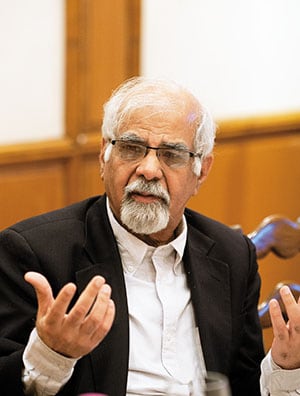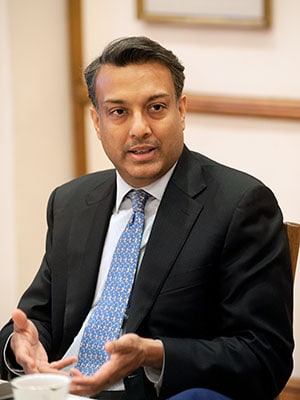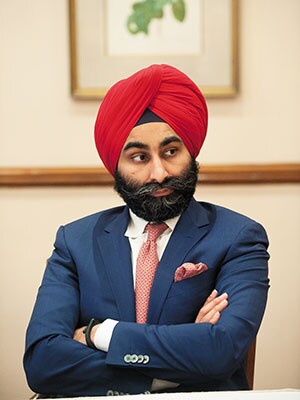
Budgeting high expectations: Why FM Jaitley has his task cut out
The 2015 budget has to bolster the Prime Minister's vision for India. It can remove bottlenecks in infrastructure, introduce measures to boost key sectors and facilitate ease of business
Prime Minister Narendra Modi had said late last year that Union Budget 2015 will be transformational and full of new ideas. Expectations from this annual exercise have only risen since then. Many, from within the industry and outside, see this as an opportunity for Modi to walk the talk and deliver on the promises he has made.
In the eighth edition of the ‘Forbes India CEO Dialogues: The Leadership Agenda’, and the first to be held in Delhi, industry leaders answered the question: Can the 2015 budget set the stage for transforming India?
The panellists included Shivinder Mohan Singh, executive vice chairman, Fortis Healthcare; Surjit Bhalla, economist and CMD of Oxus Investments (an economic research, asset management and emerging-markets advisory firm); Dilip Chenoy, managing director and CEO, National Skill Development Corporation; and Sumant Sinha, founder chairman and CEO, ReNew Power Ventures Pvt Ltd. They spent over an hour-and-a-half discussing their expectations and the impact of a potential loss for the Bharatiya Janata Party (BJP) in the Delhi elections on the central government’s approach. (This discussion took place on February 5, and the results of the Delhi polls, where the Aam Aadmi Party emerged triumphant, were declared on February 10.)
Excerpts from the discussion, moderated by R Jagannathan, editor-in-chief, Forbes India:
Jagannathan: I am not a great believer in budgets turning things around. Once in a decade you have a budget like 1991. Surjit, you have been following budgets closely. Last year’s was called the Chidambaram Budget with a saffron tinge. What do you think this one will be like? Do you think we need a radical budget or a nuts-and-bolts one?

There have been developments on the expenditure side, too. The [YV] Reddy Report on state finances clearly said that we should move away from the idea of the Centre playing a role in schemes. What he said is that the finance commission decides how much allocation should be given [to states]. Implicit in this, I hope, is the idea that if Uttar Pradesh, for instance, gets X amount of money and Akhilesh [Yadav] wants to build a temple, he will be allowed to do it. If the government replaces schemes such as the public distribution system, NREGA, fertiliser subsidy, etc over the next three years, it will have less expenditure.
I am also hoping for a significant move on direct taxation towards lowering of taxes particularly for the corporates. If the government does that, it will have to do the same for individuals as well. There is a 50 percent probability of it happening.
Jagannathan: Sumant, do you think we need a radical budget, or do you think the government shouldn’t try to do too many things in the budget?
Sumant Sinha: Expectations have been built up, and whether the government wants to or not, it needs to have something in the budget for the masses. Of course, the points that Surjit mentioned are valid. But I think the government will have to choose certain sectors that it wants to place its bets on.
Jagannathan: Are you calling for some kind of industrial policy that favours some sectors over others?
Sinha: No, the government won’t do it overtly. But by virtue of the kind of announcements it makes and the concessions it decides to grant a sector, it ends up doing just that. I believe that this government, fiscally at least, is considered to be prudent. The Prime Minister is on record saying that the budget deficit target for 2015-16 is 3.6 percent. We know that there is going to be a lot of subsidy reduction. But if the government is aiming for 3.6 percent, there has to be a further squeeze, which means it may not have much ability to spend on largesse. While it may aim for efficiency improvement in cash subsidy transfer and give a bit of flexibility to states to use the money as they would, the government will have to choose certain sectors.
It is also cognisant of the fact that the RBI (Reserve Bank of India) is watching it like a hawk. I don’t think it has the flexibility to support too many sectors. The question is, what can the budget do? To my mind, one of the sectors it will focus on is infrastructure. If you can’t remove bottlenecks in infrastructure, you can’t improve ease of doing business. Infrastructure is one sector it will support, whether it is through MAT (minimum alternate tax) reduction or some other means. A lot of sectors will demand that.
Can it curb interest subvention schemes? My view is that the government will try to hit macro headlines in the way that Surjit was talking about and on the fiscal deficit. Beyond that, I don’t think it will have room to do much.
Jagannathan: Do interest subvention schemes work against what the RBI is saying on keeping interest rates up because of whatever they think is happening with inflation? Does it essentially amount to interest rate cutting for certain sectors and saying RBI can go jump?
Sinha: If the government cuts interest rate for, let’s say, consumers, it is creating demand when the bottlenecks in the supply side have not been removed. That will not be good for inflation. But if the government does it on the supply side by building more infrastructure, then I don’t think the RBI should have issues with that.
Jagannathan: Is industry expecting too much from the budget and if so what are they expecting?
Shivinder Mohan Singh: From a personal point of view, I think budgets should stop being treated as events.
Jagannathan: They have become item numbers.
Singh: I think it is an expectation we should move away from. This government is looking at creating growth and the budget is a platform to send out a message. A lot of noise has been created and people are expecting a good budget. They are already in favour of the government and say that change will happen; all that the government has to do is stoke the fire. I am not an economist, but I certainly think that the fire will be stoked.
I know the government doesn’t have too much cash, but I do expect some tinkering on the tax front. It will be more about creating the right momentum and getting in FDI [foreign direct investment]. Keeping the hope it has created will be the government’s focus.
Jagannathan: You don’t see growth in employment? Is it only about skill development, or is there something more substantial that is blocking the creation of jobs? Can a budget start addressing that?
Dilip Chenoy: I think it’s going to be the most important budget after 1991. Maybe three years from now, we will debate over which budget was more important. The PM has said we have three Ds: Democracy, demography and demand.
Jagannathan: And now one more D: Defeat as well.
Chenoy: The challenge is that if defeat is the fourth D, then the government needs to take drastic action. In five years from now, India may have 10-12 crore new voters. He [Modi] has to show them economic growth. Therefore, this has to be a growth budget.
At this point, there is a lot of talk but very little action in the private sector. I think infrastructure will hold back growth if you don’t invest in it. PPP (public-private partnership) models don’t work well. The government will have to fix infrastructure, and we will see some significant investment in this sector.
The government has introduced campaigns and measures over the past few months whether it is financial inclusion, ‘Make in India’, or ‘Swachh Bharat’. It has made recommendations for 25 sectors in the ‘Make in India’ campaign, and each sector has a set of budget information. If you kick-start petroleum investment, for instance, do you have Rs 60,000 crore for it? If you are going to have that kind of infrastructure, you are going to promote domestic investment and domestic jobs.
Another thing that went unnoticed in the last budget is the size of our GDP. Though we have billionaires, India has far less entrepreneurs than most countries. The three main reasons for this is access to finance, difficulty in starting business and lack of innovation culture. The government has addressed the first by introducing a single window system [for investors]. You can now launch a business in three days in India. It has also addressed access to finance through a Rs 10,000-crore venture fund, and the means of financing it will kick in next year. If the entrepreneurship model is successful, and the government kick-starts demand, we may be looking at a totally different scenario.
Jagannathan: Are we going to use that [entrepreneurship] ability to drive investment and see that demand comes from that?
Chenoy: World over, population age groups are growing older. So they have reverted to production methods that save on labour. In India, there is an incentive given to industry for creating jobs. If you create jobs, 30 percent of the wages that you have to pay to create those jobs can be deducted from taxes. The government should allow it to include services industry as well. It has to find a way to get industries sitting on the fence to start investing.
Jagannathan: Both Houses of Parliament have passed a law which says that having less than 40 employees will free you from labour inspection and so on. These are the things that will help in creating jobs. Inspection Raj is over.
Chenoy: A lot has happened behind the scenes and the government has not been able to articulate it. The previous government had a PM who didn’t articulate anything. Now we have a PM who articulates, but even then, these messages have not reached the public.
Jagannathan: Sumant, one of the things we saw in the mid-term policy appraisal is that the government wants a higher dose of public investment, especially for infrastructure. The fact is that the only actor that can play a role now is the government. Assuming that it will be one of the major thrusts announced in the budget, what do you expect will happen?
Sinha: Before we start looking at fresh investments, we need to unclog existing investments. If you don’t free them up, you can’t make future investments. That is one area which the government is working on. In general, I am perhaps more on the Right as Surjit is. Therefore, I shy away from anything where the government gets more involved in business. This whole thing doesn’t sit well with the philosophy of ‘Minimum government, maximum governance’. It does not sit well with the idea that the “government has no business being in business”.
On the other side, you do have this philosophy that the government is using public sector organisations and now, under this potential garb to push investments, it is going to use the public sector further. To me, that is heading in the wrong direction. Are there short-term imperatives which justify this? Perhaps there are. Today, you can incentivise the private sector to invest in infrastructure with the right enabling framework rather than getting the public sector to invest in sectors that are not reformed.
The world is awash with liquidity. We have plenty of new entrepreneurs who are in a position to raise capital from overseas. Do you need NTPC to make 25,000 watts of solar power, or can you create an environment where the private sector can do the same? I am in the latter camp.
Jagannathan: Dilip, do you have a view on where the government should be involved?
Chenoy: The first private sector road development programme happened under the NDA [the BJP-led National Democratic Alliance]. The first private sector power came under the NDA. In our desire to make it competitive, we have tied ourselves in knots. We can restart some of those and actually have private-public partnerships then we can very quickly transform it. You can do a lot without involving government money. The biggest message that is coming is this government is about empowerment and not entitlement. The private sector will see return in investment.
Jagannathan: Surjit, even a right-winger like Arvind Subramanian [chief economic adviser to the Government of India] seems to be advocating this. He says the government has to step in, in the short term.
Bhalla: I think there is a misunderstanding on the need for privatisation or PPP or the government involvement in the economy. If you face competitive pressure, it makes no difference whether it’s owned by the government or somebody else. Ownership to me is irrelevant. Being subject to competition and accountability is more important. This government is moving in that direction. Accountability is at a premium. Competitiveness is what it wants to build. As long as there are checks and balances, I don’t care about government involvement. By definition, the private sector doesn’t have big budget resources. Given our capital market, you can’t borrow. So, PPPs are inevitable.
Jagannathan: What are the three things you would like to see in the budget?
Chenoy: I would like to see investment in infrastructure; it could be from a mix of government and private sector. Second, is creating an environment of empowerment rather than entitlement. The third thing is to get the states governed by the BJP to set the trend for those that aren’t. For instance, the labour laws in Rajasthan or the fact that MP is coming out of Bimaru (Bihar, Madhya Pradesh, Rajasthan, and Uttar Pradesh).
Singh: We need reforms in the health care sector. There should be something in the budget to promote preventive health care. We avoid it because insurance doesn’t cover it. If there is any economic structure to say that we would rather spend on OPD diagnostics, it will be good.
Chenoy: If you can get a rebate on income tax for yearly health check-ups, that will help in promoting preventive health care. To claim medical insurance, you need to spend 24 hours in the hospital. I think the government should do away with this. There are surgeries that get over in two hours but to claim insurance, I have to be in hospital for 24 hours. If they remove this clause, the beds in hospitals can be utilised three times over.
Bhalla: I want a vision statement of where the government sees India’s economy going and it has to be consistent with the reality of what it is proposing.
Jagannathan: Is there scope for cutting taxes, both individual and corporate?
Chenoy: We need lower tax rates, but we need specific support for specific sectors. It is time we choose sectors, like Sumant said. The government has shied away from choosing sectors. Germany supports the auto industry. We need a clear vision. If you have Rs 100, you can’t spend on all the sectors.
Bhalla: Choosing sectors has never worked. One of my pet phrases is that ‘there is no place to hide anywhere’. That is what the government is finding out. My one advice is that ease of doing business is important.
The government should try to lower taxes. It is a myth that Indians are under-taxed. We have a higher fiscal deficit than most countries in the world because we are spending and not because of low taxes. Only 50 percent of those who should pay taxes, are doing so. We are under-taxed in the sense that we are not compliant. Every time tax rates have been reduced, compliance has gone up. I had proposed a flat tax rate few years back but I don’t think it will happen. I think two tax slabs of 10 and 25 percent can easily be done. But we are not ready for a flat tax, though it is the best form of taxation.
Chenoy: Give rebates to money spent on credit card and mobile phones. Get everyone into the formal economy.
Sinha: My simple view is we should decrease complexity of taxes.
Jagannathan: For the last question, I want to go outside the budget. Two issues we are facing now are growth and inflation. Is inflation dead or is it going to haunt us? Or is it just good luck that oil prices fell and inflation went down. Do you see growth reviving this year?
Singh: I don’t think inflation is dead. Inflation will be under control. Growth will happen because of all the reasons you have spoken about.
Sinha: Inflation is not as big a deal as the RBI is making it out to be. Growth will pick up. In the next financial year, we could see 6.5 percent growth. But I think the year after that will look better given all the momentum that is picking up. I will be more bullish about medium- to long-term growth. It takes time to prepare the foundation and then reap the benefits. This government seems to be working on fast forward, so things will probably happen faster. I think it will take 12 to 18 months before we can start seeing tangible growth.
Chenoy: There is a feel-good factor. There are sections of growth in parts of the economy. It can become widespread. Two dangers are external shocks, something happens in Europe and we are slightly vulnerable to it, and lack of a decent monsoon. I hope the PM is lucky with this year’s monsoon as [he is] with oil prices.
Bhalla: Neither luck nor international crude prices have brought down inflation. It is because of good policies of this government. You ain’t seen nothing yet. I think inflation is dead. By dead I mean somewhere around 4 percent. The global average is 1.5 to 3 percent. There is a very decent chance that growth will surprise on the upside for 2015-16. I would be surprised if it isn’t 7 to 7.5 percent because the external environment is very good and will continue to be.
(This story appears in the 30 November, -0001 issue of Forbes India. To visit our Archives, click here.)








